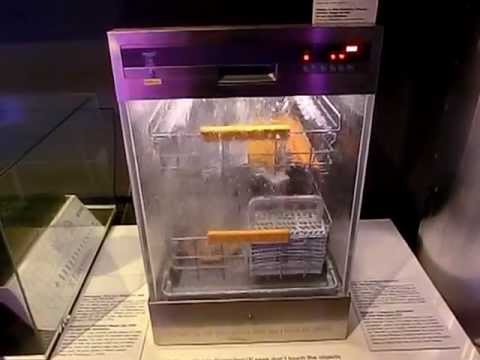Have you ever wondered how your trusty dishwasher transforms a pile of dirty dishes into sparkling clean ones? It's a modern marvel that saves time and effort in the kitchen. In this guide, we'll dive into the fascinating world of dishwashers, exploring their inner workings and the components that make them so efficient. Whether you're a tech enthusiast or just someone who loves a clean plate, there's something here for everyone!
The Components of a Dishwasher

To truly understand how dishwashers work, it's essential to get familiar with their main components. Each part plays a crucial role in ensuring your dishes come out spotless. Let’s break it down:
- Water Inlet Valve: This is where the magic begins. When you start your dishwasher, the water inlet valve opens, allowing water to flow into the machine from your household plumbing.
- Spray Arms: These are the rotating arms inside the dishwasher that spray water onto your dishes. Most dishwashers have two or three spray arms, strategically designed to reach every nook and cranny of your pots and pans.
- Heating Element: Hot water is crucial for effective cleaning. The heating element warms the water to the optimal temperature, typically between 120°F and 150°F (49°C to 65°C), helping to dissolve grease and food particles.
- Detergent Dispenser: This component releases dishwasher detergent at the right time during the wash cycle. A good detergent is essential for breaking down food residues and stains.
- Filters: Dishwashers have filters that trap food particles and debris, preventing them from re-depositing on your clean dishes. Regular cleaning of these filters is key to maintaining dishwasher performance.
- Pump and Motor: The pump circulates water through the spray arms, while the motor drives the pump. Together, they create the pressure needed to spray water effectively.
- Rinse Aid Dispenser: Rinse aid helps reduce water spots and improves drying. It works by making water sheet off dishes, allowing for a more efficient drying process.
Understanding these components can give you a new appreciation for your dishwasher. Each part works in harmony like a well-rehearsed orchestra, ensuring your kitchen remains a clean and inviting space. Next time you load your dishwasher, think about all the intricate processes happening behind the scenes to deliver those shiny results!
Also Read This: Quick Guide to Download Synced Dailymotion Videos
3. How Dishwashers Clean Dishes

Have you ever wondered what happens inside your dishwasher when you load it up with dirty dishes? It’s like a little magic box that transforms grime into gleaming plates! Here’s how it works:
When you close the door and start a cycle, the dishwasher fills up with water. This water is heated to a high temperature, which helps to break down food particles and grease. Here’s a quick rundown of the cleaning process:
- Pre-Rinse Phase: Initially, the dishwasher sprays water to pre-rinse the dishes, loosening any stuck-on food.
- Main Wash: Next, detergent is released into the hot water, creating a powerful cleaning solution. The spray arms then rotate, distributing this soapy water onto your dishes.
- Rinsing: After the wash cycle, the dishwasher drains the dirty water and rinses the dishes with fresh water to remove any detergent residue.
- Drying: Finally, most dishwashers use either heat or a fan to dry the dishes, ensuring they're ready to use again.
But what makes the cleaning really effective? It's all about the design of the dishwasher. The spray arms are strategically placed to ensure every surface of the dishes is hit with water. Plus, modern dishwashers have filters to capture food debris, allowing for a more thorough clean.
And let’s not forget about the power of detergent! The right detergent, whether liquid, powder, or pod, can make a huge difference. Some detergents even contain enzymes that break down proteins and starches, ensuring your dishes come out spotless.
Also Read This: The Best Methods for Downloading Videos from Dailymotion Quickly
4. Understanding Different Dishwasher Cycles
Dishwashers come with a variety of cycles to tackle different cleaning challenges. Knowing which cycle to use can lead to cleaner dishes and save energy. Here’s a breakdown of the most common dishwasher cycles:
| Cycle Name | Description | Best For |
|---|---|---|
| Normal Cycle | The standard cycle that balances cleaning and energy efficiency. | Everyday dishes, like plates and utensils. |
| Heavy Duty Cycle | Increased wash and rinse times for heavily soiled dishes. | Casserole dishes, pots, and pans. |
| Quick Wash Cycle | A shorter cycle for lightly soiled dishes. | When you need clean dishes in a hurry! |
| Eco Cycle | Uses less water and energy, taking longer to clean. | Eco-conscious users or lightly soiled items. |
| Sanitize Cycle | Uses higher temperatures to kill bacteria. | Baby bottles and cutting boards. |
Choosing the right cycle not only optimizes the cleaning process but also prolongs the life of your dishes and your dishwasher. For example, using the heavy-duty cycle on delicate glassware could lead to breakage, while the quick wash might leave residue on greasy pots.
In summary, understanding how your dishwasher cleans and the various cycles available can transform dish duty from a chore into a breeze. So next time you load up your dishwasher, you'll know exactly how it works its magic!
Also Read This: Is Dailymotion a Safe Platform? A Comprehensive Guide to Trust
5. Energy Efficiency and Water Usage
When it comes to modern appliances, energy efficiency is a hot topic, and dishwashers are no exception. In fact, the latest models are designed with energy conservation in mind, making them not only eco-friendly but also cost-effective for your household. Let’s dive into how dishwashers achieve this.
Understanding Energy Ratings
Most dishwashers come with an energy rating label, often seen as a key indicator of their efficiency. The Energy Star label, for example, signifies that a dishwasher meets energy efficiency guidelines set by the U.S. Environmental Protection Agency.
Water Usage Matters
One of the most surprising facts about dishwashers is their water efficiency. Contrary to the belief that washing dishes by hand saves more water, modern dishwashers actually use significantly less water. For instance, a typical dishwasher uses about 3 to 5 gallons of water per cycle, compared to the 20 gallons or more it might take to wash the same number of dishes by hand.
Smart Features
Many newer models are equipped with smart sensors that optimize water and energy usage based on the load size and soil level. This means that if you’re running a light load, the dishwasher will consume less water and energy compared to a full load. It’s like having a personal assistant for your dishwashing needs!
Tips for Maximizing Efficiency
- Run Full Loads: Always try to run your dishwasher with a full load to make the most out of each cycle.
- Use Eco Modes: Take advantage of eco-friendly settings available on many dishwashers.
- Avoid Pre-rinsing: Many modern dishwashers are designed to handle dirty dishes without the need for pre-rinsing.
By being mindful of energy efficiency and water usage, you not only save money on your utility bills but also do your part in conserving resources. So, the next time you load your dishwasher, remember that you’re making an environmentally friendly choice!
Also Read This: Learn Beautiful Mehndi Designs on Dailymotion
6. Common Dishwasher Issues and Troubleshooting
Even the best dishwashers can run into problems from time to time. Knowing how to troubleshoot these issues can save you time and money. Here are some common problems you might encounter, along with handy solutions.
1. Dishes Not Cleaning Properly
If your dishes aren’t coming out clean, it could be due to:
- Clogged Spray Arms: Check if the spray arms are blocked by food debris or mineral buildup. Remove and clean them regularly.
- Poor Loading: Make sure you’re loading the dishes correctly. Avoid overcrowding, as this can obstruct water flow.
2. Leaks
Leaks can occur due to:
- Worn Door Seals: Inspect the rubber seals around the door for cracks or wear. Replacing these can often solve the problem.
- Loose Hoses: Check the hoses for any loose connections or damage.
3. No Power
If your dishwasher isn’t turning on, consider these possibilities:
- Tripped Circuit Breaker: Check your home's circuit breaker to see if the dishwasher is on a tripped circuit.
- Faulty Door Latch: A malfunctioning door latch can prevent the dishwasher from powering up. Ensure it’s closing properly.
4. Unpleasant Odors
Unpleasant smells can be a sign of trapped food particles. Regularly clean the filter and run a cycle with a cup of vinegar placed on the top rack to neutralize odors.
By understanding these common issues and how to troubleshoot them, you can keep your dishwasher running smoothly, ensuring that it serves you well for years to come. Remember, regular maintenance is key to avoiding most of these problems!
Also Read This: How to Make Butterfly with Cloth: Fun Craft Tutorial on Dailymotion
7. Choosing the Right Dishwasher for Your Needs
When it comes to purchasing a dishwasher, the choices can be overwhelming. With various brands, styles, and features, how do you know which one is the perfect fit for your kitchen? Let's break it down into manageable steps!
First, consider your household size and cooking habits. If you’re a solo diner or a couple, a compact model might suffice. However, families or those who frequently entertain guests may find that a larger capacity dishwasher is essential. Here are some points to ponder:
- Capacity: Look for dishwashers that offer different rack configurations. Models with adjustable or removable racks can accommodate larger pots and pans.
- Energy Efficiency: Check the Energy Star rating. An energy-efficient model can save you money on your utility bills in the long run.
- Noise Level: If you have an open-concept kitchen, you’ll want a quieter model (around 40 dB or lower is ideal).
- Washing Cycles: Different cycles cater to various needs—normal, heavy, quick wash, and eco-friendly options. Think about what you’ll need most!
Next, consider the features that matter most to you. Some dishwashers come with:
| Feature | Description |
|---|---|
| Smart Technology | Wi-Fi connectivity allows you to control and monitor your dishwasher from your smartphone. |
| Soil Sensors | Automatically adjusts the wash cycle based on how dirty your dishes are. |
| Third Rack | A top rack for small items like utensils, maximizing space in the lower racks. |
Lastly, set a budget. Dishwashers can range from a few hundred to a couple of thousand dollars. Remember, while it’s tempting to go for the cheapest option, a high-quality model could save you money on repairs and energy costs down the line.
8. Conclusion and Final Thoughts
In conclusion, understanding how dishwashers work and knowing how to choose the right one can greatly enhance your kitchen experience. Investing in a dishwasher that meets your specific needs not only saves time but can also elevate your cooking and dining experience.
So, whether you're a busy parent juggling work and house chores or a home chef who loves gourmet cooking, there’s a dishwasher out there tailored just for you. Remember to evaluate your space, lifestyle, and budget before making a decision. And always read reviews and compare models to ensure you’re getting the best deal!
In the end, a good dishwasher can be a game-changer in maintaining a clean and efficient kitchen. Happy dishwashing!
 admin
admin








